Articles(冠词)的用法
- 格式:pdf
- 大小:195.39 KB
- 文档页数:16
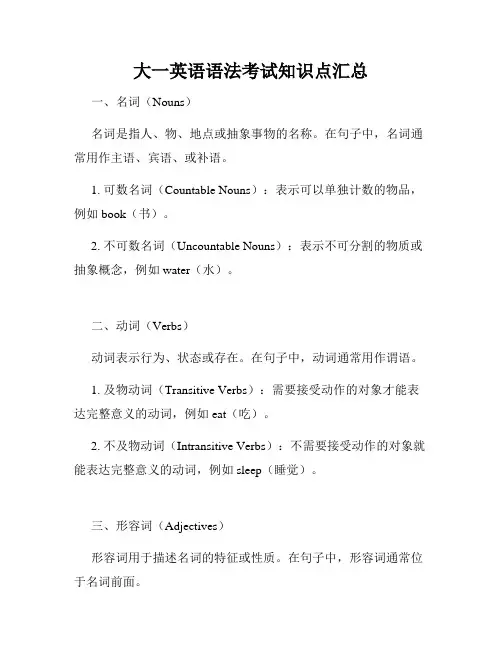
大一英语语法考试知识点汇总一、名词(Nouns)名词是指人、物、地点或抽象事物的名称。
在句子中,名词通常用作主语、宾语、或补语。
1. 可数名词(Countable Nouns):表示可以单独计数的物品,例如book(书)。
2. 不可数名词(Uncountable Nouns):表示不可分割的物质或抽象概念,例如water(水)。
二、动词(Verbs)动词表示行为、状态或存在。
在句子中,动词通常用作谓语。
1. 及物动词(Transitive Verbs):需要接受动作的对象才能表达完整意义的动词,例如eat(吃)。
2. 不及物动词(Intransitive Verbs):不需要接受动作的对象就能表达完整意义的动词,例如sleep(睡觉)。
三、形容词(Adjectives)形容词用于描述名词的特征或性质。
在句子中,形容词通常位于名词前面。
1. 基本形容词(Basic Adjectives):用于表达物品的描述,例如beautiful(美丽的)。
2. 比较级形容词(Comparative Adjectives):用于比较两个物品的描述,例如bigger(更大的)。
3. 最高级形容词(Superlative Adjectives):用于比较三个或三个以上物品的描述,例如biggest(最大的)。
四、副词(Adverbs)副词用于修饰动词、形容词、或其他副词,用来表示时间、地点、方式、程度等。
1. 时间副词(Adverbs of Time):用于描述动作发生的时间,例如now(现在)。
2. 地点副词(Adverbs of Place):用于描述动作发生的地点,例如here(这里)。
3. 方式副词(Adverbs of Manner):用于描述动作的方式,例如carefully(小心地)。
4. 程度副词(Adverbs of Degree):用于描述动作或状态的程度,例如very(非常)。
五、代词(Pronouns)代词用于替代名词,以避免重复使用。
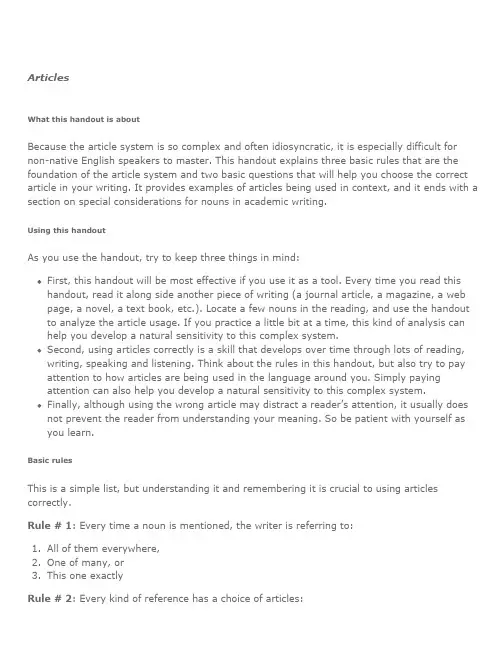
ArticlesWhat this handout is aboutBecause the article system is so complex and often idiosyncratic, it is especially difficult for non-native English speakers to master. This handout explains three basic rules that are the foundation of the article system and two basic questions that will help you choose the correct article in your writing. It provides examples of articles being used in context, and it ends with a section on special considerations for nouns in academic writing.Using this handoutAs you use the handout, try to keep three things in mind:First, this handout will be most effective if you use it as a tool. Every time you read this handout, read it along side another piece of writing (a journal article, a magazine, a web page, a novel, a text book, etc.). Locate a few nouns in the reading, and use the handout to analyze the article usage. If you practice a little bit at a time, this kind of analysis can help you develop a natural sensitivity to this complex system.Second, using articles correctly is a skill that develops over time through lots of reading, writing, speaking and listening. Think about the rules in this handout, but also try to pay attention to how articles are being used in the language around you. Simply payingattention can also help you develop a natural sensitivity to this complex system.Finally, although using the wrong article may distract a reader’s attention, it usually does not prevent the reader from understanding your meaning. So be patient with yourself as you learn.Basic rulesThis is a simple list, but understanding it and remembering it is crucial to using articles correctly.Rule # 1: Every time a noun is mentioned, the writer is referring to:1. All of them everywhere,2. One of many, or3. This one exactlyRule # 2: Every kind of reference has a choice of articles:1. All of them everywhere…(Ø, a/an, the)2. One of many……………..(Ø, a/an)3. This one exactly…………(Ø, the)(Ø = no article)Rule # 3: The choice of article depends upon the noun and the context. This will be explained more fully below.Basic questionsTo choose the best article, ask yourself these questions:1. “What do I mean? Do I mean all of them everywhere, one of many, or this one exactly?”2. “What kind of noun is it? Is it countable or not? Is it singular or plural? Does it have anyspecial rules?”Your answers to these questions will usually determine the correct article choice, and the following sections will show you how.When you mean “all of them everywhere”Talking about “all of them everywhere” is also called “generic reference.” We use it to make generalizations: to say something true of all the nouns in a particular group, like an entire species of animal.When you mean “all of them everywhere,” you have three article choices: Ø, a/an, the. The choice of article depends on the noun. Ask yourself, “What kind of noun is it?”1. Non-count nouns = no article (Ø)a. Temperature is measured in degrees.b. Money makes the world go around.2. Plural nouns = no article (Ø)a. Volcanoes are formed by pressure under the earth’s surface.b. Quagga zebras were hunted to extinction.3. Singular nouns = thea. The computer is a marvelous invention.b. The elephant lives in family groups.Note: We use this form (the + singular) most often in technical and scientific writing togeneralize about classes of animals, body organs, plants, musical instruments, andcomplex inventions. We do not use this form for simple inanimate objects, like books or coat racks. For these objects, use (Ø + plural).1. Singular nouns = a/an (when a single example represents the entire group)In certain situations, we always use “a” or “an.” These situations include:1. Referring to something that is one of a number of possible things.Example: My lab is planning to purchase a new microscope. (Have you chosen oneyet? No, we’re still looking at a number of different models.)2. Referring to one specific part of a larger quantity.Example: Can I have a bowl of cereal and a slice of toast? (Don’t you want thewhole box of cereal and the whole loaf of bread? No, thanks. Just a bowl and aslice will be fine.)3. With certain indefinite quantifiers.Example: We met a lot of interesting people last night. (You can also say “a bunchof” or “a ton of” when you want to be vague about the exact quantity. Note thatthese expressions are all phrases: a + quantifier + of.)Exception: “A few of” does not fit this category. See Number 8 in the next sectionfor the correct usage of this expression.4. Specifying information associated with each item of a grouping.Example: My attorney asked for $200 an hour, but I’ll offer him $200 a weekinstead. (In this case, “a” can substitute for the word “per.”)5. Introducing a noun to the reader for the first time (also called “first mention”). Use“the” for each subsequent reference to that noun if you mean “this one exactly.”Example: I presented a paper last month, and my advisor wants me to turn thepaper into an article. If I can get the article written this semester, I can take abreak after that! I really need a break!Note: The writer does not change from “a break” to “the break” with the second mentionbecause she is not referring to one break in particular (“this break exactly”). It’sindefinite—any break will be fine!!When you mean “this one exactly”Talking about “this one exactly” is also called “definite reference.” We use it when both the reader and the writer can identify the exact noun that is being referred to.When you mean “this one exactly,” you have two article choices: Ø, the. The choice of article depends on the noun and on the context. Ask yourself, “What kind of noun is it?”1. (Most) Proper nouns = no article (Ø)a. My research will be conducted in Luxembourg.b. Dr. Homer inspired my interest in Ontario.Note: Some proper nouns do require “the.” See the special notes on nouns below.2. Non-count nouns = thea. Step two: mix the water with the boric acid.b. The laughter of my children is contagious.3. Plural nouns = thea. We recruited the nurses from General Hospital.b. The projects described in your proposal will be fully funded.4. Singular nouns = thea. Bring the umbrella in my closet if it looks like rain.b. Did you get the visa you applied for?In certain situations, we always use “the” because the noun or the context makes it clear that we’re talking about “this one exactly.” The context might include the words surrounding the noun or the context of knowledge that people share. Examples of these situations include:1. Unique nounsa. The earth rotates around the sun.b. The future looks bright!2. Shared knowledge (both participants know what’s being referred to, so it’s notnecessary to specify with any more details)a. The boss just asked about the report.b. Meet me in the parking lot after the show.3. Second mention (with explicit first mention)a. I found a good handout on English articles. The handout is available online.b. You can get a giant ice cream cone downtown. If you can eat the cone in fiveseconds, you get another one free.4. Second mention (with implied first mention—this one is very, very common)a. Dr. Frankenstein performed a complicated surgery. He said the patient isrecovering nicely. (“The patient” is implied by “surgery”—every surgery has apatient.)b. My new shredder works fabulously! The paper is completely destroyed. (Again,“the paper” is implied by “shredder.”)5. Ordinals and superlatives (first, next, primary, most, best, least, etc.)a. The first man to set foot on the moon…b. The greatest advances in medicine…6. Specifiers (sole, only, principle, etc.)a. The sole purpose of our organization is…b. The only fact we need to consider is…7. Restricters (words, phrases, or clauses that restrict the noun to one definite meaning)a. Study the chapter on osmosis for the test tomorrow.b. Also study the notes you took at the lecture that Dr. Science gave yesterday.8. Plural nouns in partitive -of phrases (phrases that indicate parts of a larger whole)(Note: Treat “of the” as a chunk in these phrases—both words in or both words out)a. Most of the international students (emphasis on part of the group)b. Most international students (emphasis on the group as a whole)c. Several of the risk factors (emphasis on part of the group)d. Several risk factors (emphasis on the group as a whole)e. A few of the examples (emphasis on part of the group)f. A few examples (emphasis on the group as a whole)Note:“Few examples” is different from “a few examples”. Compare:The teacher gave a few good examples. (emphasizes the presence of good examples) The teacher gave few good examples. (emphasizes the lack of good examples)Article flowchartFor the more visually oriented, this flowchart sketches out the basic rules and basic questions.Some notes about nounsUncountable nounsAs the name suggests, uncountable nouns (also called non-count or mass nouns) are thingsPlaces (collective, regional, “the”): the Great Lakes, the Middle East, the Caribbean Note: Proper nouns in theory names may or may not take articlesWhen a person’s name is part of a theory, device, principle, law, etc., use “the” when the name does not have a possessive apostrophe. Do not use “the” when the name has an apostrophe. Examples:the Doppler effect Einstein’s theory of relativitythe Pareto index Murphy’s lawthe Reimann hypothesis Halley’s cometNote: Articles change when proper nouns function as adjectivesNotice how the article changes with “Great Lakes” in the examples below. When place names are used as adjectives, follow the article rule for the noun they are modifying.Examples:I’m studying ……the Great Lakes. (as noun)…a Great Lakes shipwreck.(as adjective with “one of many” singular noun)…the newest Great Lakes museum. (as adjective with “this one exactly” singularnoun)…Great Lakes shipping policies. (as adjective with “one of many” plural noun)…Great Lakes history. (as adjective with “one of many” uncountable noun)。


Articles (冠词)冠词:a(n), the, 对冠词的考查题型有:1. 与数词的连用;2.与最高级的连用;3.与other 连用;4.泛指,特指用法;5.感叹句中;6.such/ so …that 句型等;7. 零冠词。
1.I don’t quite like _________. It’s too hard.A. the fifth lessonB. the lesson fiveC. five lessonsD. the fifth lessons2. Where are the students? Are they in __________?A. the Room 406B. Room 406C. the 406D. 406 Room3.—Can I help you madam? —I’m looking for ________ pair of shoes for my daughter.A. theB. anC. aD. some4. This is _________ song I’ve told you about. Isn’t it ___________ beautiful one?A. the, theB. a, aC. the, aD. a, the5. Lots of visitors come to Shanghai because she is ________ city.A. so a beautifulB. very a beautifulC. such beautifulD. quite a beautiful6.—_________ weather! It’s raining! —Bad luck. We have to stay at home all day.A. What a fineB. How fineC. What badD. How bad a7. I think you have dropped _____ “r” in writing “merry”. A. an B. a C. the D. /8. _________ boy hurt his leg. He is in _________ hospital now.A. A, aB. The, aC. The, theD. The, /9. Tracy knows very well how to play _____ piano. A. / B. a C. an D. the10.—There are two new cars in front of the company. —One is mine, and ____ is the manager’s.A. otherB. anotherC. the otherD. others11. That’s ______ useful book. I have read it already. A. the B. an C. a D. /12. We have never seen __________ exciting film before.A. suchB. so aC. such anD. such a13. Does Tom often play _____ football after _____ school?A. /, /B. /, theC. the, /D. a, /14. __________ cold it is today! A. What B. How C. What a D. How a15. _________ Blacks are going to the park this Sunday. Why don’t we go for _________ walk?A. A, aB. An, /C. The, aD. /, a16. ________ it is today! Let’s go to fly a kite in the park, shall we?A. What a fine weatherB. How fine weatherC. How fine a weatherD. What fine weather17. _______ good time the children had on Children’s Day!A. How aB. How anC. What aD. What an18. It’s Mid-Autumn Festival. ______ moon is very bright. A. / B. The C. A D. An19. Black broke his leg. He has just had __________ X-ray examination. _________ doctor saidhe needed ____________ operation.A. a, The, anB. a, A, anC. an, A, anD. an, The, an20. Mr. Smith always give me __________ hand when I am in trouble.A. aB. anC. theD. /21.—What do you think of the football match?—Wonderful! The Chinese football team has never played _________.A. betterB. bestC. worseD. the worst22.—Where’s Xiao Ming? —He’s having _____________ rest over there.A. aB. anC. theD. /。
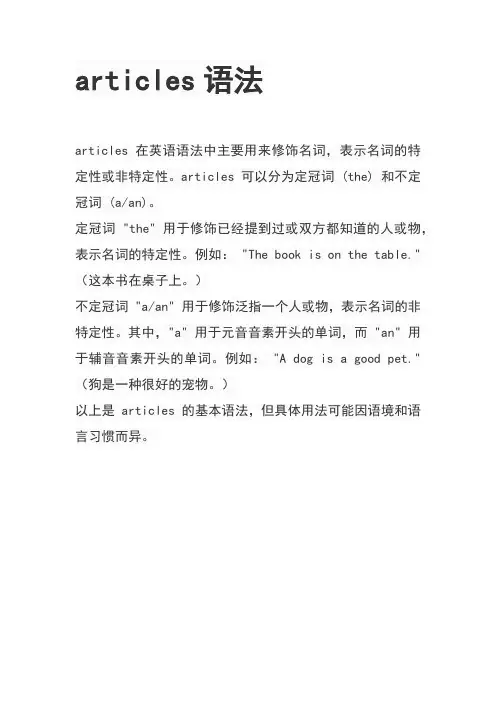
articles语法
articles 在英语语法中主要用来修饰名词,表示名词的特定性或非特定性。
articles 可以分为定冠词 (the) 和不定冠词 (a/an)。
定冠词 "the" 用于修饰已经提到过或双方都知道的人或物,表示名词的特定性。
例如: "The book is on the table."(这本书在桌子上。
)
不定冠词 "a/an" 用于修饰泛指一个人或物,表示名词的非特定性。
其中,"a" 用于元音音素开头的单词,而 "an" 用于辅音音素开头的单词。
例如: "A dog is a good pet."(狗是一种很好的宠物。
)
以上是 articles 的基本语法,但具体用法可能因语境和语言习惯而异。

浅谈法语中部分冠词和缩合冠词的运用法语中的冠词在句子中起到限定名词的作用,帮助读者和听者理解名词的具体含义。
在法语中,冠词有两种类型:部分冠词(articles partitifs)和缩合冠词(articles contractés)。
1. 部分冠词(articles partitifs)部分冠词用于表示不可数名词的泛指和部分具体数量。
常用的部分冠词有:- du / de la / de l' :用于表示不可数名词的泛指,相当于英语中的some 或any。
例如:- Il y a de l'eau. (有些水。
)- Tu veux de l'orange ? (你要些橙子吗?)- des :用于表示不可数名词数量的部分或不可数名词的具体数量。
例如:- Ils ont mangé des pommes. (他们吃了几个苹果。
)缩合冠词是由介词à 或 de 和冠词合并而成的,在使用的过程中需要注意合并规则。
- à + le = au :例如:- Ils vont aux États-Unis. (他们去美国。
)- Je suis du Canada. (我来自加拿大。
)有些介词可以缩合的同时还要与冠词合并,例如:- C'est le livre de la professeur. (这是教授的书。
)通过对部分冠词和缩合冠词的运用,可以使表达更加具体明确。
但是需要注意的是,冠词的使用规则在不同的句子和语境中可能会有所变化,因此有时候需要根据具体情况进行分析和判断。
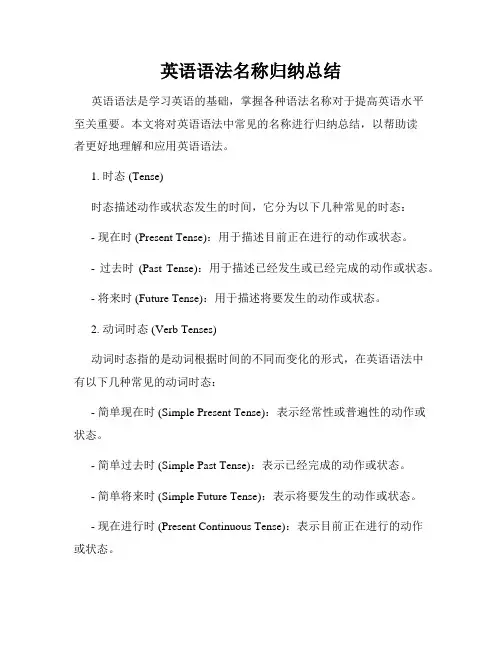
英语语法名称归纳总结英语语法是学习英语的基础,掌握各种语法名称对于提高英语水平至关重要。
本文将对英语语法中常见的名称进行归纳总结,以帮助读者更好地理解和应用英语语法。
1. 时态 (Tense)时态描述动作或状态发生的时间,它分为以下几种常见的时态:- 现在时 (Present Tense):用于描述目前正在进行的动作或状态。
- 过去时(Past Tense):用于描述已经发生或已经完成的动作或状态。
- 将来时 (Future Tense):用于描述将要发生的动作或状态。
2. 动词时态 (Verb Tenses)动词时态指的是动词根据时间的不同而变化的形式,在英语语法中有以下几种常见的动词时态:- 简单现在时 (Simple Present Tense):表示经常性或普遍性的动作或状态。
- 简单过去时 (Simple Past Tense):表示已经完成的动作或状态。
- 简单将来时 (Simple Future Tense):表示将要发生的动作或状态。
- 现在进行时 (Present Continuous Tense):表示目前正在进行的动作或状态。
- 过去进行时 (Past Continuous Tense):表示过去某个时间正在进行的动作或状态。
- 将来进行时 (Future Continuous Tense):表示将来某个时间正在进行的动作或状态。
- 完成时态 (Perfect Tenses):表示过去某个时间之前完成的动作或状态。
- 现在完成时 (Present Perfect Tense):表示过去某个时间之前完成的动作或状态,与当前时间有关。
- 过去完成时 (Past Perfect Tense):表示过去某个时间之前完成的动作或状态,与过去时间有关。
- 将来完成时 (Future Perfect Tense):表示将来某个时间之前完成的动作或状态,与将来时间有关。
3. 语态 (Voice)语态描述动作的主体和受体之间的关系,常见的语态有以下两种:- 主动语态 (Active Voice):表示动作的执行者是主语。
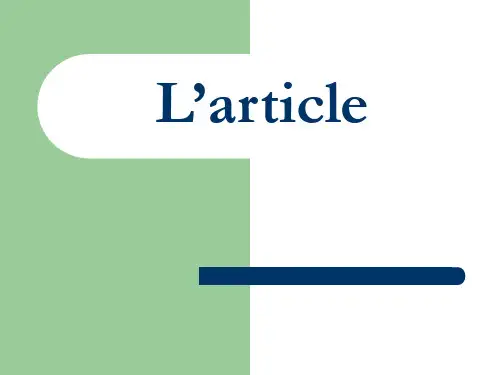

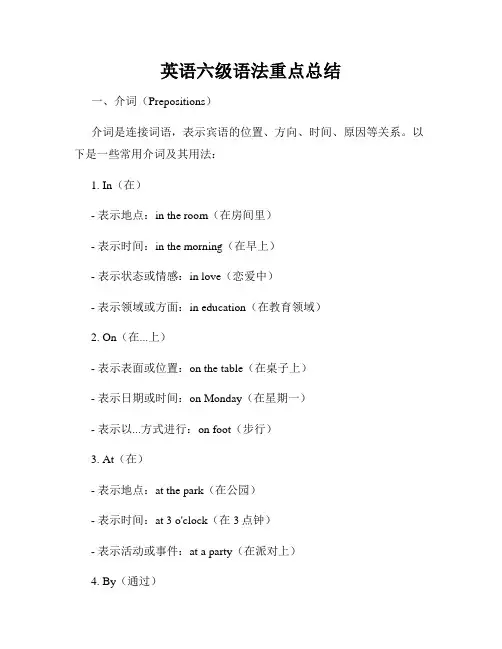
英语六级语法重点总结一、介词(Prepositions)介词是连接词语,表示宾语的位置、方向、时间、原因等关系。
以下是一些常用介词及其用法:1. In(在)- 表示地点:in the room(在房间里)- 表示时间:in the morning(在早上)- 表示状态或情感:in love(恋爱中)- 表示领域或方面:in education(在教育领域)2. On(在...上)- 表示表面或位置:on the table(在桌子上)- 表示日期或时间:on Monday(在星期一)- 表示以...方式进行:on foot(步行)3. At(在)- 表示地点:at the park(在公园)- 表示时间:at 3 o'clock(在3点钟)- 表示活动或事件:at a party(在派对上)4. By(通过)- 表示交通工具:by car(乘坐汽车)- 表示方式:by email(通过电子邮件)二、冠词(Articles)冠词用于限定名词的范围,分为定冠词(the)和不定冠词(a/an)。
1. 定冠词the- 特指某一事物或特定人:the book(那本书)、the President(总统)- 用于特定名词的单数形式:the sky(天空)、the University of Oxford(牛津大学)2. 不定冠词a/an- 用于表示单数的可数名词,但不特指某一事物:a book(一本书)、an apple(一个苹果)三、动词时态(Verb Tenses)动词时态用于表示动作发生的时间。
以下是英语六级中常见的动词时态:1. 一般现在时:主语+动词原形+其他。
例:She writes articles for a newspaper.2. 一般过去时:主语+动词过去式+其他。
例:I watched a movie last night.3. 现在进行时:主语+be动词+动词ing形式+其他。
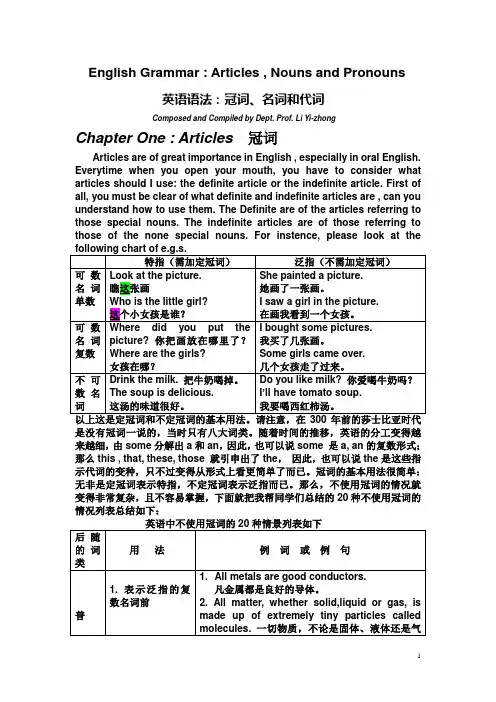
English Grammar : Articles , Nouns and Pronouns英语语法:冠词、名词和代词Composed and Compiled by Dept. Prof. Li Yi-zhongChapter One : Articles 冠词Articles are of great importance in English , especially in oral English. Everytime when you open your mouth, you have to consider what articles should I use: the definite article or the indefinite article. First of all, you must be clear of what definite and indefinite articles are , can you understand how to use them. The Definite are of the articles referring to those special nouns. The indefinite articles are of those referring to those of the none special nouns. For instence, please look at the是没有冠词一说的,当时只有八大词类。
随着时间的推移,英语的分工变得越来越细,由some 分解出a 和an ,因此,也可以说some 是a, an 的复数形式; 那么this , that, these, those 就引申出了the , 因此,也可以说the 是这些指示代词的变种,只不过变得从形式上看更简单了而已。
冠词的基本用法很简单:无非是定冠词表示特指,不定冠词表示泛指而已。
小学七年级英语语法知识点一、名词(Nouns)名词是指人、动物、事物或抽象概念的名称。
它可以表示单数或复数。
1. 单数名词单数名词表示一个人、动物、物品或概念。
例如:book(书)、girl(女孩)、dog(狗)、idea(想法)等。
2. 复数名词复数名词表示多个人、动物、物品或概念。
通常在名词后面加上“-s”或“-es”。
例如:books(书籍)、girls(女孩们)、dogs(狗们)、ideas(想法们)等。
3. 不可数名词不可数名词表示无法分割或计数的物质、抽象概念等。
它们通常没有复数形式。
例如:water(水)、milk(牛奶)、happiness(幸福)等。
二、代词(Pronouns)代词是用来替代名词的词语,可以指示人、事物、抽象概念等。
1. 人称代词人称代词用来代替人或一群人。
例如:I(我)、you(你)、he (他)、she(她)、we(我们)、they(他们)等。
2. 物主代词物主代词用来表示所有权或所属关系。
例如:my(我的)、your(你的)、his(他的)、her(她的)、our(我们的)、their(他们的)等。
3. 反身代词反身代词用来指示动作的执行者也是动作的承受者。
例如:myself (我自己)、yourself(你自己)、himself(他自己)、herself(她自己)、ourselves(我们自己)、themselves(他们自己)等。
三、动词(Verbs)动词是指行为、状态或事件等的词语,用来表示人或事物的动作或状态。
1. 一般现在时一般现在时表示经常性的动作、习惯、自然规律或常识。
动词的第三人称单数形式通常在后面加上“-s”或“-es”。
例如:I play(我玩)、he plays(他玩)、she goes(她去)、we eat(我们吃)等。
2. 现在进行时现在进行时表示正在进行的动作或现阶段正在发生的事情。
通常由“be动词+动词的ing形式”构成。
例如:I am playing(我正在玩)、heis running(他正在跑)、we are studying(我们正在学习)等。
文章的英语单词
“文章”的英文是:Articles
读音:英['ɑːtɪkl]美['ɑːrtɪkl]
n. 文章;物品;条款;[语]冠词
vt. 订契约
词语用法
1、article的基本意思是“物件”“物品”,常指一套中之一。
2、article还可作“文章”解,指报纸、杂志上的短文。
引申可表示“项目”“条款”,指法律上的规定,也可指协议或合同上的契约。
article还可作“冠词”解。
3、an article of常可接不可数名词,意为“一件”。
扩展资料:
1、She asked him to contribute a biweekly article on European affairs. 她让他每两周写一篇有关欧洲情况的文章。
2、If you don't return the article to the shop within a week, you forfeit your chance of getting your money back.
如果你不把物品归还商店,你就丧失了取回钱的机会。
冠词Article冠词是虚词,单独没有词义,用在名词的前面,帮助指明名词的含义。
冠词分为三种,定冠词、不定冠词和零冠词。
1、不定冠词a 和an 的用法。
a 和an 的意思一样,常译为“一个”,a 用于辅音音素前面,an用在原因音素前面。
1) 第一次提到某人或某事物时,用不定冠词a或an起介绍作用。
例如:E.G. 我们部门最近来了一个新同事。
There is a new colleague in our department recently.我以5000元买了一个笔记本电脑。
I bought a laptop at a price of 5000 yuan.我昨天在动物园看见一只大象。
I saw an elephant in the zoo yesterday.2) 表示一类中的一个,任何一个。
例如:E.G. 孩子需要爱。
A child needs love.大象比马更强壮。
An elephant is stronger than a horse.3) 用于专有名词之前,表示说话人不知道的人或事。
例如;E.G. 有一个叫Smith的先生给你打过电话。
A Mr. Smith called you.一位姓王的人正在找你。
A Wang is looking for you.4) 在月份,星期及evening, night, morning, afternoon等名词前有修饰定语时,一律用a.E.G. 在东北三月份冷是很平常的。
A cold March is usual in the Northeast.我是在一个阳光明媚的早上遇到他的。
It was on a sunny morning that I met him.我出生在一个严寒的冬天。
I was born on a freezing winter.5) 在使用不定冠词的过程要注意的事项●一般在口语中只用A\AN表示一个,只在强调数字的时候才用ONE●要注意以下这种情况:I have a black and white dog.\ I have a black and a white dog.两个句子是不同的。
Used with permission from the RPI Writing Center by John R. KohlIntroductionThe articles a, an, and the are difficult for many non-native speakers of English to learn to use properly. Some of the rules that govern article usage are very subtle; only years of experience with the language will enable you to understand and apply these rules. However, Table 3 will help you eliminate many errors in article usage from your writing.In order to use Table 3, however, you have to understand two concepts: countability and definiteness. These concepts are explained in detail below. The last part of this handout discusses article usage with proper nouns as well as the difference between a and an. At the very end of the handout is an exercise that you can do to test your understanding.CountabilityCountable nouns refer to people, places, or things that can be counted (one dollar/two dollars, one house, two houses). They [these countable nouns] can always be made plural--usually by adding -s or some other variation of the plural ending, e.g.student(s), countri(es), child(ren). A few words are the same in both the singular and plural forms (deer, sheep).Uncountable nouns often refer to food, beverages, substances, or abstractions (meat, tea, steel, information); some uncountable nouns (but not the abstract ones) can be made countable by adding a count frame in front of them (two gallons of milk, six blocks of ice, a bar of soap, a bunch of celery).Unfortunately, there is no clear-cut distinction between countable and uncountable nouns. Some nouns can be both countable and uncountable even without adding count frames. For example, as an uncountable noun, experience refers to abstract knowledge or skill that can be gained by observing or participating in events. As a singular or plural countable noun (experience/experiences), the word experience refers to a particular instance (or instances) of participation in events. Similarly, the uncountable noun glass is a substance made from silicates; a glass (singular) is something you drink from; and glasses (plural) are frames containing lenses that correct imperfect vision.There are other exceptions to the countable/uncountable distinction as well. Moreover, a noun that is countable in your native language may be uncountable in English, and vice-versa. For example, soapis countable in Spanish but uncountable in English. However, as long as you are aware of these differences they probably will not cause you much difficulty.LEARNING HINT #1: The best thing to do is to memorize some of the most frequently occurring uncountable nouns (shown in Table 1 below), and to look up other nouns in a dictionary if you are not sure whether they are countable or uncountable. If your dictionary does not indicate whether nouns are countable or uncountable, then you should consult another dictionary, such as The Oxford Advanced Learner's Dictionary.In the Oxford dictionary, nouns are countable unless they are designated by the letter [u]. If a noun can be either countable or uncountable (with different definitions, as in the examples given above), then the uncountable definitions are preceded by [u], and the countable definitions are preceded by [c], as in the following example:ad-ven-ture n. 1 [c] a strange or unusual happening (The explorer told the boys about his adventures in the Arctic). 2 [u] risk; danger (Robin Hood lived a life of adventure).Table 1: Some Common Uncountable English Nouns∙Food and Drink:bacon, beef, beer, bread, broccoli,butter, cabbage, candy, cauliflower, celery, cereal,cheese, chicken, chocolate, coffee, corn, cream,fish, flour, fruit, ice cream, lettuce, meat, milk, oil,pasta, rice, salt, spinach, sugar, tea, water, wine,yogurt∙Nonfood Substances: air, cement, coal, dirt,gasoline, gold, ice, leather, paper, petroleum,plastic, rain, rubber, silver, snow, soap, steel, wood,wool.∙Abstract nouns:advice, anger, beauty, confidence,courage, employment, fun, happiness, health,honesty, information, intelligence, knowledge, love,poverty, satisfaction, truth, wealth∙Others: biology (and other areas of study), clothing,equipment, furniture, homework, jewelry, luggage,lumber, machinery, mail, money, news, poetry,pollution, research, scenery, traffic, transportation,violence, weather, workDefinitenessA noun is definite if it refers to something specific that is known to both the writer/speaker and the reader/listener. (Note: You shouldmemorize this definition!) For example, if Jane needs to drive somewhere, she might ask her father, "May I use the car?" She uses the definite article the because both she and her father know which car Jane is referring to (the family car). But later Jane might say to her friend Bill, "I saw a funny-looking dog today." She uses the indefinite article a because she knows which dog she saw, but Bill doesn't.Table 2 below illustrates that there are four possible conditions involved in this decision, but only one results in a noun that is definite.Table 2: Matrix of Definiteness/Indefiniteness *In the following examples, definiteness is determined bywhether the Writer/Speaker and the Reader/Listener knowsspecifically what is being referred to:∙Definite: "Can I use the car?"Writer/Speaker: YESReader/Listener: YES∙Indefinite: "I saw a funny-looking dog today."Writer/Speaker: YESReader/Listener: NO∙Indefinite: "I heard that you once wrote a bookabout ecology."Writer/Speaker: NOReader/Listener: YES∙Indefinite: "I need to buy a new belt."Writer/Speaker: NOReader/Listener: NO* adapted from Brown, R., A First Language. Cambridge,MA: Harvard University Press, 1973.Five Sources of DefinitenessThere are five principal ways in which a reader/listener can know specifically what a noun is referring to (that is, five reasons a noun might be considered definite):1.The noun has been previously mentioned.o I saw a funny-looking dog yesterday [first mention,indefinite]. It looked like a cross between a Pekineseand a German shepherd. When it saw my cat, thedog ran away [second mention, definite].2. A superlative or ranking adjective makes the noun's identityspecific.o The tallest girl in the class is 6'2" tall. [There can be only one girl who is the tallest.]o Please read the fourth paragraph on page 3. [There can be only one fourth paragraph.]o Today is the most important day of my life. [There can be only one day that is the most important.]3.The noun describes a unique person, place, or thing.o The earth revolves around the sun once every 365 days. [There is only one earth and only one sun--inour solar system, that is!]4. A modifying word, phrase, or clause follows the noun andmakes it clear which specific person or thing you arereferring to. But not every noun that is modified in this way is definite; it depends largely on the situation and on what you can reasonably expect your listener/ reader to know about.o Do you remember the girl who went camping with us?[Using the here implies that there was only one girlwho went camping with you; otherwise the clausewho went camping with us would not be sufficient toidentify the particular girl that you are referring to. Ifthere were two girls, then you would have to be morespecific, saying perhaps "Do you remember the girlfrom Iowa who went camping with us last May?"] o John is reading a book about quantum physics. [Here the noun book is modified by the phrase aboutquantum physics. But there is undoubtedly more thanone book about quantum physics. Therefore, to makebook definite, we would have to add moreinformation: "the book about quantum physics thatwas assigned by Professor Jackson last week."]5.The context or situation makes the noun's identity clear. Forexample, you might ask someone to "Close the door." You would use the because it would undoubtedly be clear to both of you which door you were referring to. Similarly, if you tell someone that you are going to the library, that person willassume that you are talking about whichever library is most familiar to both of you--RPI's Folsom Library, for example.Again, you have to be sure that your reader or listener has the same context or situation in mind that you are thinking of; otherwise, he or she will be confused by your use of the.For example, one student wrote the following sentence: o This magazine helps women analyze the problematic situation and offers possible remedies.But this was the first time she had mentioned a problematicsituation. Her readers were therefore confused because heruse of the word the implied that they were already supposedto know which problematic situation she was referring to.Choosing the Appropriate ArticleIn order to choose the appropriate article for a noun, you first need to decide whether the noun is singular. One way to determine this is to ask yourself whether you could put the number "one" in front of it. For example, you can say "one experiment," but not "one knowledge" or "one examples"; therefore, "experiment" is singular, whereas "knowledge" is uncountable and "examples" is plural.Table 3 below shows that if the noun is singular, you must use either "the" or "a"/"an" in front of the noun, depending on whether it is definite (known to both you and your readers) or not.If the noun is not singular, then it must be either plural or uncountable. Table 3 below shows that article usage is the same for both plural and uncountable nouns will use either "the" or "0" (no article) in front of the noun. Again, the decision depends on whether the noun is definite or not.Table 3: Choosing the Appropriate Article1.Singular Noun (one of something that is countable)Is the noun definite?YES: Use "the"a) The painting in the living room was given to meby an old friend.o Painting and living room are singularbecause we are referring to only onepainting and one living room.o Painting is definite because the followingphrase, in the living room, makes it clearwhich painting we are referring to (reason 4,above). (However, it could be indefinite ifthere is more than one painting in the livingroom that the speaker could be referring to;in that case, the speaker would say "Apainting...."o Living room is definite because it is clearfrom the context of the situation that thespeaker is referring to the living roomclosest to where he and the listener arestanding (reason 5 above).NO: Use "a" or "an"b) Eugene's lunch consisted of a sandwich, twocookies, and a can of soda.o Sandwich and can are both singular (there is only one of each). They could be definiteif the listener/reader had seen Eugene'ssandwich and can of soda, or if they hadbeen mentioned before. However, thespeaker/writer's choice of the indefinitearticle a for both nouns tells us that they areunknown to the listener/reader.2.Plural or Uncountable NounIs the noun definite?YES: Use "the"c) The technical reports that I gave you are topsecret. (plural and definite)o Reports, is plural (note that it ends in -s)because we are talking about more than onereport. It is definite because the followingphrase, that I gave you, makes it clear to thereader/listener which reports you arereferring to (reason 4, above).d) The wool that is produced in Scotland is used tomake sweaters and other garments. (uncountable and definite)o Wool is uncountable (you cannot say one wool). It is definite because the followingclause, that is produced in Scotland, makesit clear which wool you are referring to(reason 4, above).NO: Use 0 (no article)e) Long reports are difficult to write. (plural and indefinite)o Reports is plural (note that it ends in -s). The lack of an article in front of it means that thespeaker/writer is talking not about particularreports that are known to the listener/reader,but about all long reports in general.f) Scotland's major exports are wool and oil. (uncountable and indefinite).o Wool and oil are both uncountable nouns (you cannot say one wool or one oil in thiscontext). They are indefinite because theyrefer to these two substances in general, notto particular shipments of wool and oil thatare known to the reader/listener.LEARNING HINT #2: One of the most common mistakes that non-native speakers make with articles is using a or an with plural or uncountable nouns (a students and a research would be incorrect). But consider that the articles a and an are derived from the word one. Thus, it is illogical to use a or an with a plural noun, isn't it? It is also illogical to use a or an with an uncountable noun--After all, how can you have one of something that is uncountable?An easy way to eliminate a lot of mistakes is to look through your writing for every occurrence of a and an. Then examine the noun that follows each a or an. If the noun is either plural or uncountable, then you have made a mistake, and you should refer to Table 3 to determine whether to use the or 0 instead.LEARNING HINT #3: Often mistakes occur not because a writer has used the wrong article (e.g., a or an instead of the), but because the writer has used no article at all for a singular noun. Notice in Table 3 that every singular noun must have an article in front of it.LEARNING HINT #4: Notice that every definite noun takes the article the, regardless of whether it is singular, plural, or uncountable. Therefore, if you cannot decide whether a noun is singular, plural, or uncountable, go on to the next step and ask yourself whether it is definite (known to both the writer/speaker and the reader/listener) or not. If it is definite, then use the.Using Articles with Proper Nouns (this section is slightly modified for use by ELP)So far, we have been talking only about using articles with common nouns. The rules for proper nouns are more complex.Proper nouns are names of particular people, places, and things (John F. Kennedy, New York City, Notre Dame Cathedral), and for that reason they are inherently definite. Nevertheless, the definite article is not used with most singular proper nouns. For example, if you are referring to your friend George, you wouldn't say "The George and I went to a movie last night." The only times "the" is used with a name like this are: a) when you want to be emphatic, as in "the Elizabeth Taylor" (to emphasize that you are talking about the famous actress, and not about another woman with the same name), and b) when you are actually using the name as a common noun, as in "the George that I introduced you to last night" (the real meaning of this phrase is "the man named George..."). Plural names, on the other hand, are always preceded by the: theJohnsons, the Bahamas, etc.Singular geographical names are very irregular with respect to article usage. For example, singular names of continents (Asia, Africa), mountains (Mount Fuji), and bays (San Francisco Bay) do not take the article the, but regions (the Crimea), deserts (the Sahara), and other geographical entities do.Most place names which include the seem to be structures composed of a noun and a modifier: The United States, the Dominican Republic, the Empire State (New York’s nickname) and The Empire State Building. However, names with New, North, South, East or West do not use the: New York, South Carolina, New South Wales, East Anglia.Great Britain does not use the, but the Great Lakes does. Pennsylvania has both the University of Pennsylvania (in Philadelphia) and Penn State University (in College Park).Indeed, the use of articles with singular proper nouns is complex and hence difficult to learn. For this reason, the best thing to do is to memorize whether the proper nouns that you use frequently are used with or without the.Examples:State StreetDelaware CountyGreat Britainthe(former) Soviet Unionthe University of VirginiaRensselaer Polytechnic InstituteHarvard UniversityOrganizations typically have the in their names. However, the abbreviations may or may not be said with the:The United Nations (the U.N.)The Organization of Petroleum Exporting Countries (OPEC, not ‘the OPEC’)The pattern seems to be that, if the abbreviation is said as one word, it will not take the. On the other hand, if theabbreviation is said as letters, the will be used:The CIAThe FBIUNESCONAFTA"A" Versus "An"This last topic is undoubtedly the easiest, because most non-native speakers already know about the difference between a and an. They are simply two variations of the indefinite article. A is used before words that begin with consonant sounds (a rock, a large park) and an is used before vowel sounds (an interesting subject, an apple).However, note that the choice of a or an depends on pronunciation, not spelling. Many words that begin with the vowel -u- are preceded by a instead of an because the -u- spelling is often pronounce -yu-, as in useful ("a useful idea"), and uranium ("a uranium isotope"). In addition, in a few words borrowed from French, the initial consonant -h- is not pronounced: an heir to the throne, an hour-long lecture, an honorable agreement, etc.A Strategy for SuccessKeep in mind that native speakers of English seldom use articles incorrectly; therefore, any errors that you make are very noticeable and distracting to them. That is why you should make an effort to use articles correctly.Study this handout--particularly Five Sources of Definiteness, Table 3, and the Learning Hints. Memorize the definition of definiteness ("known to both the writer/speaker and thereader/listener"). Then try the Exercise toward the end of this handout; the correct answers are provided on the following page so you can check your work.In the future, whenever you write in English, you will need to proofread your writing carefully and to apply the rules for article usage very deliberately. With practice, you can learn to use articles correctly--not only in writing, but also in speech!References∙Brown, Roger. A First Language: The Early Stages.Cambridge, MA: Harvard University Press, 1973. (Folsomlibrary P136 .B7)∙Celce-Murcia, Marianne, and Larsen-Freeman, Diane. The Grammar Book: An ESL/EFL Teacher's Course. Rowley,MA: Newbury House, 1983. 171-202.∙Hacker, Diana. The Bedford Handbook for Writers. Boston: St. Martin's, 1991. 312-17. (Available at the Writing Center) ∙Hornby, A.S. The Oxford Advanced Learner's Dictionary of Current English. 3rd ed. London: Oxford UP, 1974.(Available at the Writing Center)∙Master, Peter A. "Teaching the English Article to Foreign Technical Writing Students." The Technical Writing Teacher13.3 (1986): 203-10. (Folsom library reserve 808 .T49)∙Quirk, Randolph, Sidney Greenbaum, Geoffrey Leech, and Jan Svartvik. A Comprehensive Grammar of the EnglishLanguage. New York: Longman, 1985. (Folsom libraryPE1106 .C65 1985)ExerciseInstructions: Fill in each blank with the appropriate article. If no article is required, put a "0" in the blank. The nouns that the articles go with are in italics.1. _______(a) Decline and Fall of ______(b) Roman Empire isa famous book about that subject.2. ________(a) complexity of _______(b) problem of______(c) decline and fall of the Roman Empire is madeevident by _______(d) wide variety of causes that areemphasized in varying degrees by _______ (e) differentauthors.3.Fortunately, ________(a) concise formulation of EdwardGibbon serves as _________(b) widely accepted basis for_______(c) modern discussion of _________(d) problem.4.According to Gibbon, _________(a) empire reached its peakduring _______(b) administration of ________(c) twoAntonines.5.After that, however, ________(a) extent of ________(b)Roman conquest became too great to be managed by_______(c) Roman government, and _______(d) declinebegan.6. ______(a) military government was weakened and finallydissolved as ______(b) barbarians were allowed toconstitute ______(c) ever-growing percentage of ______(d)Roman legions.7. ______(a) victorious legions began to dominate and corrupt_______(b) government, weakening it at ______(c) timewhen it most needed ______(d) strength to overcome_______(e) other problems.Answers and Explanations to the ExercisesNOTE: The explanations refer to reasons given in the section on "Five Sources of Definiteness."1.a) The -- singular; definite because of reason 4 (followingmodification: of the Roman Empire).b) the -- singular; definite because of the precedingadjective: Roman. This is not one of the five principalsources of definiteness, but in this case, "Roman empire" isvery specific (especially since "Roman" is derived from theproper noun, "Rome"), and the reader would be expected toknow that there was only one empire that is known as theRoman empire in English.2.a) The -- singular; definite because of reason 4 (followingmodification: of the problem...).b) the -- singular; definite because of reason 4 (followingmodification: of the decline and fall of the Roman Empire).c) the -- singular; definite because of reason 4 (followingmodfication: of the Roman Empire).d) the or a -- singular; could be either definite or indefinite.Even though a long string of modifiers follows the noun, thereader still might not be familiar with the variety of causesthat the writer is referring to.e) 0 -- plural; indefinite because the reader has no way ofknowing which different authors the writer is referring to.3.a) the -- singular; definite because of reason 4 (followingmodification: of Edward Gibbon).b) a -- singular; indefinite because there could be more thanone widely accepted basis for modern discussion of theproblem (the modification is not sufficient to make the noununique).c) 0 -- uncountable; indefinite. can be either countable oruncountable; here it is being used in the abstract,uncountable sense. It is indefinite because there could bemore than one modern discussion of the problem (themodification is not sufficient to make the noun unique).d) the -- singular; definite because of reason 1 (previouslymentioned).4.a) the -- singular; definite because of reason 1 (previouslymentioned).b) the -- singular; definite because of reason 4 (followingmodification: of the two Antonines).c) the or 0 -- plural; could be either definite or indefinite. Thewriter's use of the indicates that there were two and only twoAntonine emperors. Use of 0 would indicate that there weremore than two Antonine emperors.5.a) the -- singular; definite because of reason 4 (followingmodification: of the Roman conquest).b) the -- Conquest in this context is uncountable, meaning"the area or territory which was conquered." Because thepreceding adjective, Roman, is derived from a proper name (Rome), it makes the following noun unique in this context.c) the -- singular; definite. As in 5b, the preceding adjective,Roman, makes it clear which government is referred to in this context. However, note that in another context, it might be necessary to add a following modification in order tomake the noun definite (e.g., "the Roman government of the third century A.D.")d) the -- singular; definite because of reason 1 (previouslymentioned).6.a) The -- singular; definite because of reasons 1 and 5(Roman government was previously mentioned, and it isclear from the context that military government is alsoreferring to the Roman government).b) 0 -- plural; indefinite (not previously mentioned, nor isthere any other source of definiteness).c) an -- singular; indefinite. There could be more than onegroup, other than the barbarians, who constituted ever-growing percentages of the Roman legions; thus,modification is not sufficient to make the noun definite.d) the -- plural; definite. As in 5b and 5c, the precedingadjective, Roman, is sufficient to make it clear which legions are being referred to in this context. In another context,additional modification might be required to make the noun definite (e.g., "the Roman legions that invaded Britian in 6B.C.")7.a) 0 -- plural; probably indefinite. The author is notnecessarily referring to any particular group of victoriouslegions; moreover, even though legions have beenmentioned before, victorious legions have not; thus, thecriterion of previous mention does not apply.b) the -- singular; definite because of reason 1 (previouslymentioned).c) a or the -- singular; If we interpret when it most needed...as modifying time, then time is definite because of reason 4.However, most native speakers interpret both at a time and when it most needed... as adverbial modifiers modifyingweakening, so the the noun would be interpreted as being indefinite.d) the or 0 -- Strength can be either uncountable (theabstract quality of strength) or singular (a particular instanceof that abstract quality). So it is either singular and definite because of reason 4 (following modification: to overcome other problems), or uncountable and indefinite. Both would be equally acceptable, so it just depends on how the writer is thinking.e) 0 -- plural; indefinite (other problems have not been mentioned previously, and there is no other source of definiteness).。